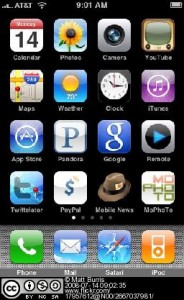This is part of a regular series of articles exploring some of the terms used in e-learning (view other articles in the series). We’ll do our best to break down the jargon and explain what things are from a basic perspective.
Today’s focus is on ‘mobile apps’, which are applications for which can be run on mobile devices. Mobile apps are a relatively new phenomenon, only appearing in the last couple of years, but quickly gaining popularity.
Many mobile apps are accessed through smartphones. Smartphones are mobile phones which also have the abilities of simple computers. Popular smartphone models include the iPhone, Blackberry and Android phones. Some other devices can also run mobile apps using wireless internet access instead of phone access (e.g. MP3 players like the iPod Touch and tablets like the iPad and Blackberry PlayBook). Most modern smart-phones can connect to wireless internet as well as a mobile network to allow cheaper access to the internet.
Mobile apps are small software programmes which perform an additional task on your phone. For example, there are apps to organise your diary, check the weather, play games, view the periodic table, search for information, identify a song you heard, figure out your location, make a blog post, etc. In fact there are hundreds of thousands of apps available, with the number steadily growing. Some are free and you have to pay for others.
Many mobile apps are built around the immediate needs of the user, helping users get the information they need whenever they need it as fast as they can. Others take advantage of the multimedia capabilities of smartphones by allowing the recording, display and manipulation of different media. Due to the small screen sizes, most mobile apps have simple interfaces, and take advantage of touchscreen interfaces to allow you to intuitively use the application.
Mobile learning (sometimes referred to as m-learning) is an educational concept of using mobile phones, including mobile apps, for the purposes of facilitating and enhancing learning. Some examples of learning benefits for mobile applications include:
- True anywhere, anytime access to online learning materials whenever students want them
- Data gathering projects, where students use their mobile phones to gather field data, interviews or images from outside and bring them back into the classroom
- Changed classroom dynamics, with students encouraged to use their mobile phones to find answers to questions posed in class and report them back during class
- Quizzes during lectures to ensure comprehension, start discussion or get feedback from students
- Facilitation of group project communication and administration
Shortly we should have a mobile application available to give students access to Blackboard and some other university information. There will also be further work to develop scenarios around mobile learning activities that can be done in the classroom.
Read more about mobile apps in the Educause Learning Initiative’s 7 things you should know about Mobile Apps for Learning.




Pingback: Coming soon: SHUgo, a mobile app for Sheffield Hallam « e-learning at Sheffield Hallam
Pingback: What is RSS? « e-learning at Sheffield Hallam
Pingback: Our mobile app SHUgo is now available « e-learning at Sheffield Hallam
Pingback: SHUgo now available for Android and mobile web « e-learning at Sheffield Hallam
Pingback: What is a QR code? « e-learning at Sheffield Hallam
Pingback: What is Skype? « e-learning at Sheffield Hallam
Pingback: Blogs, Journals and Wikis – important changes « e-learning at Sheffield Hallam
Pingback: SHUgo 2.0 is here! « e-learning at Sheffield Hallam
Pingback: SHUgo 2.0 « LIS Update
Pingback: Teaching in a mobile world « e-learning at Sheffield Hallam